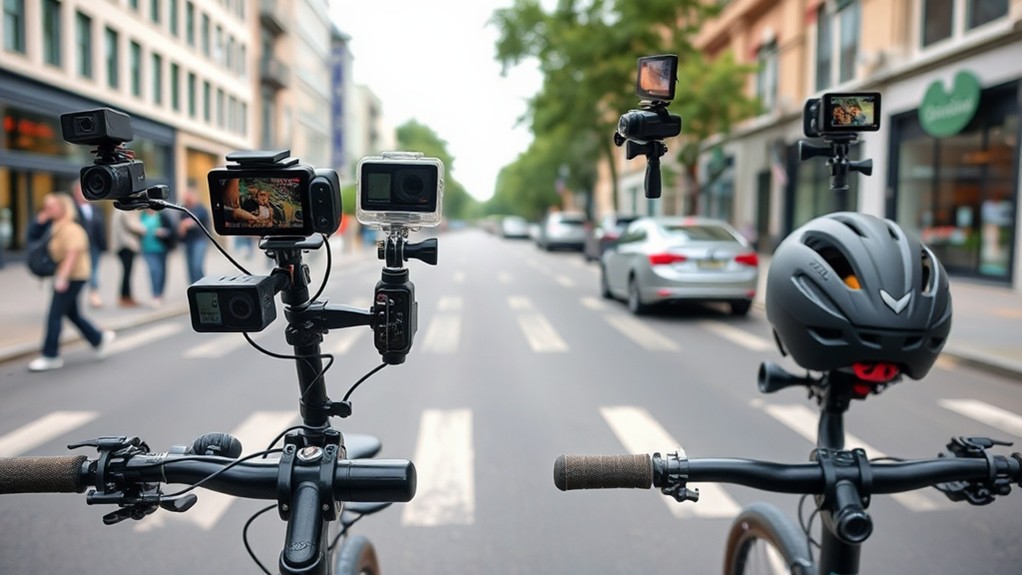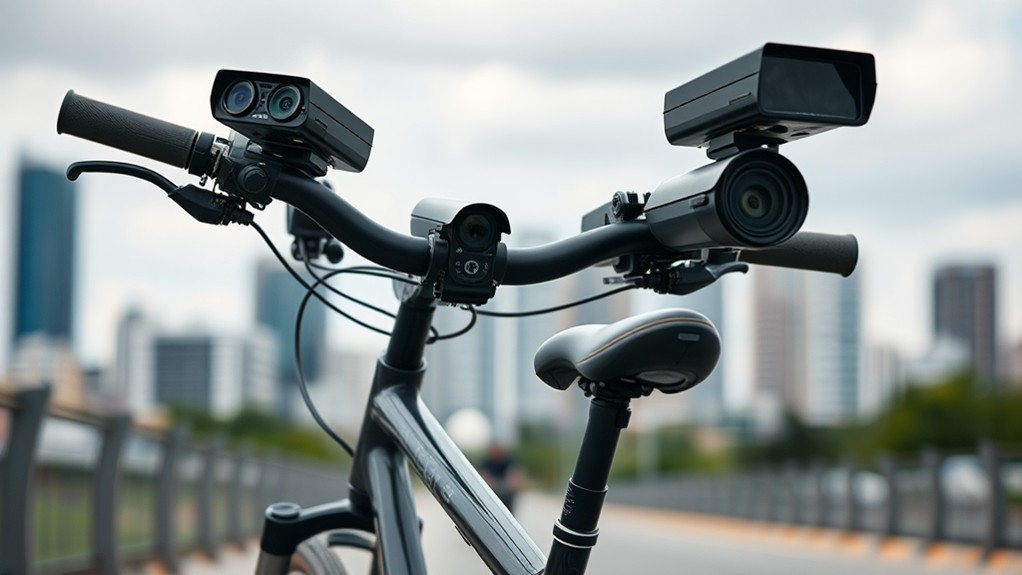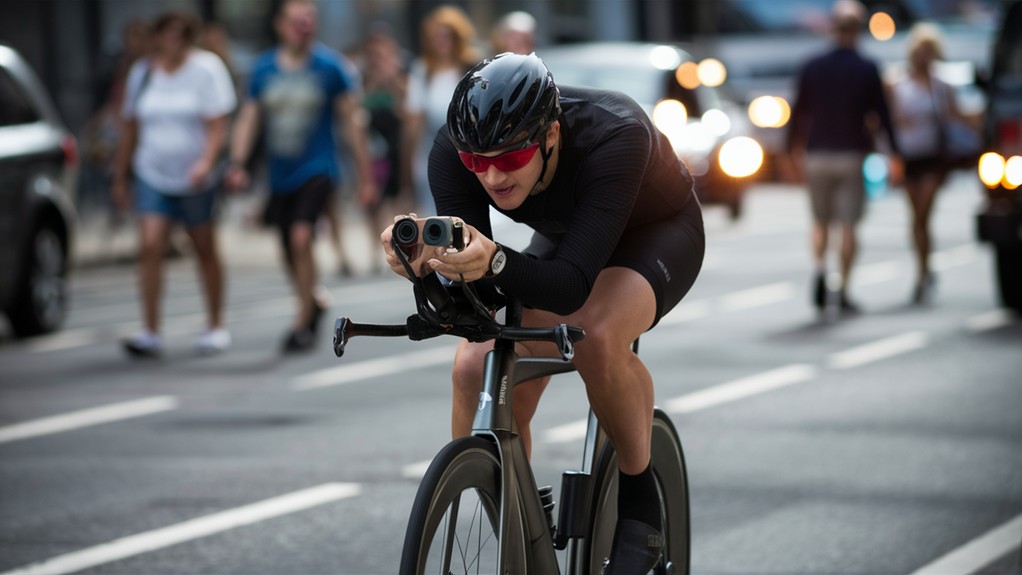When setting up a bike security camera system, consider high-resolution cameras with night vision and a combination of fixed and pan-tilt-zoom (PTZ) cameras for thorough surveillance. Choose cameras with a minimum resolution of 720p and features like motion detection, which activates recording upon detecting movement. Effective camera placement is key – install cameras between 8 to 10 feet high, focusing on key entry points and well-lit areas. Regular maintenance and review of camera angles are essential for optimal performance. By investing in bike security cameras and integrating features like GPS tracking and smart locks, you can appreciably reduce theft risk – but there's more to creating a strong system, and taking the right steps will make all the difference.
Bike Security Essentials
Key Security Considerations
- Install high-resolution cameras with night vision capabilities to capture clear footage, even in low-light conditions.
- Combine fixed and PTZ (Pan-Tilt-Zoom) cameras for thorough surveillance coverage of bike storage areas and entry points.
- Integrate bike security cameras with smart home systems for remote monitoring and alerts directly to your smartphone.
Best Practices for Optimal Camera Performance
- Regularly maintain and adjust the positioning of security cameras to guarantee optimal performance.
- Confirm critical areas are consistently monitored to prevent bike theft.
Choosing the Right Camera
When selecting a bike security camera, it's vital to reflect on several factors to guarantee you choose the right model for your needs. To start, examine camera features such as resolution, aiming for at least 720p for clear footage, with higher resolutions like 4-5.3k offering even better detail for significant evidence.
Other key features to evaluate include:
- Night vision for improved surveillance in low-light conditions
- Motion detection to activate recording only when movement is detected
- Battery life, aiming for around an hour of recording time for action cameras and longer runtime for dedicated cycling dash cams
Recording formats also play an important role in bike security cameras. Look for models that support different formats to assure compatibility with your devices.
Evaluating the mounting options available is also important, as this can influence the camera's angle and stability during rides, impacting the quality of recorded footage.
Lastly, choose a camera with user-friendly app integration for live monitoring and easy access to recorded footage, improving the complete experience and effectiveness of your bike security setup.
Effective Camera Placement

Now that you've selected the right bike security camera, it's time to focus on where and how you'll install it. Effective camera placement is vital for capturing high-quality footage and deterring potential bike thieves.
Optimal Installation Height
Mount your camera at a height of 8 to 10 feet to minimize tampering risks while capturing a broad coverage area. This height likewise allows you to capture clear footage of potential intruders.
Strategic Camera Placement
Position your camera to focus on key entry points such as doors, windows, and staircases to monitor high-traffic areas effectively.
Verify outdoor cameras are placed in well-lit areas to improve footage clarity, especially during low-light conditions.
Installation Tips
- Use drill templates for precise camera placement, guaranteeing stable and secure installations.
- Regularly review camera angles and placements to adjust for changes in the environment and maintain effective monitoring coverage.
Enhancing Surveillance Capabilities
By bolstering your security setup with the right features, you can greatly improve the surveillance capabilities of your bike security camera. To start, consider integrating night vision and motion detection capabilities. Night vision allows your camera to capture clear footage even in low-light conditions, while motion detection conserves storage space by only recording when movement is detected.
Some key features to look for in a bike security camera include:
- High-definition resolution (minimum 720p) for clear images and easy identification of potential thieves
- Smart-enabled capabilities for remote access and alerts through mobile apps, allowing you to monitor your bike in real-time and receive notifications of suspicious activity
- 360-degree camera capabilities to minimize blind spots and provide thorough coverage of your bike's surroundings
Regular maintenance is likewise crucial for optimal performance. Make sure to clean your camera's lenses and check camera angles regularly to verify that your camera consistently provides clear and reliable footage.
Securing Your Bike System

You've fortified your bike security camera with advanced features and regular maintenance to improve its surveillance capabilities.
Now, it's crucial to secure your bike system by integrating it with other security measures. Consider investing in a U-lock, chain lock, or smart lock that can be monitored remotely via a smartphone app. Furthermore, install a bike alarm that can alert you in case of potential theft or tampering.
Integrated Systems for Improved Security
To optimize your bike's security, integrate your bike security camera with other safety features. Here are some options:
- Motion-sensitive lights that can deter potential thieves
- GPS tracking devices that allow you to locate your bike in real-time
- Smart locks that can alert you when someone tries to tamper with your bike
User Training for Effective System Use
To guarantee you're getting the most out of your bike security system, invest in user training. Familiarize yourself with the features and settings of your bike security camera, along with other integrated systems.
This will allow you to respond quickly and effectively in case of a security breach.
Frequently Asked Questions
How to Install CCTV Camera Complete Guide?
To install a CCTV camera, you'll determine the optimal placement, focusing on key entry points, then choose the right camera type, secure the mount, and connect it to a DVR or NVR system for storage.
How Much Area Can a Security Camera Cover?
When choosing a security camera, you'll want to evaluate its field of view to determine the area it can cover. Strategically plan camera placement to enhance coverage, typically around 30-40 feet, depending on the model.
What Is the Coverage Distance of CCTV Camera?
You'll find CCTV cameras covering distances from 30 to 100 feet, depending on lens types and specs. Consider installation tips, like mounting at optimal heights, to enhance coverage and capture clear images with your chosen camera.
How Long Do Surveillance Cameras Keep Footage?
You typically keep surveillance footage for several days to weeks, but that can vary depending on storage capacity. You'll additionally consider footage retention and legal considerations, such as data protection laws and required storage periods.
